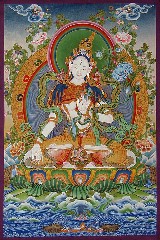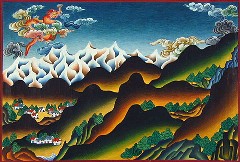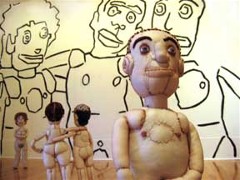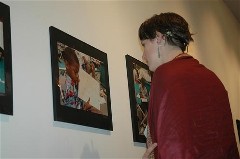What follows are a series of posts by students in Colette Copeland’s art-writing class at the University of Pennsylvania:
Post by Michael Poll:

photo by Gideon Mandel
The Body at Risk, at the International Center for Photography in New York, spans time, place, and genre to provide numerous unique perspectives on the fragility of human existence. The photos range from domestic scenes of tenement life during the 1930s by Lewis Wickes Hine (1874-1940) to those of Gideon Mandel (b. 1959) chronicling the epidemic of A.I.D.S. in Africa.
The exhibit, curated by Carol Squiers, displays the work of 16 photographers.
One portion of the exhibit, which is on Farm Security Administration labor camps during the 1940s, features a grouping of the work of multiple photographers. Photographs of the camps were included as models of a progressive health system that included sanitary living and eating conditions, in spite of the tents that were used as homes. This section included the works of Russell Lee (1903-1986), Jack Delano (Jack Ovcharov) (1904-1997), John Collier Jr. (1913-1992), M. Collins (1912-1985), and Dorothea Lange (1895-1965).
The rest of the exhibit features works grouped by photographer.
W. Eugene Smith’s photographs of Maude Callen, nurse midwife, which ran in Life on Dec. 3, 1951, brought a public awareness to the extreme lack of child-bearing care for the poor.
David T. Hanson’s work went beyond the simple photograph: each work was a triptych comprised of topographical map, aerial color photograph, and an E.P.A. description of the site pictured.
Others in the show included Eugene Richards, Donna Ferrato, Lori Grinker, Sebastiao Salgado, and Ed Kashi. Kashi’s series Aging in America portrayed the varying ways in which people age in the United States. The title of one photograph was particularly striking: “Pole vaulters in the 75+ category relax as they wait for their turn. Natural attrition thins the ranks for the highest age categories, 2001.”
Overall, the exhibit is most interesting for the intellectual, social, and political commentaries that it provides the viewer. Taken individually, the works are not masterpieces, but as a collective whole, the works gain power through their collective commentary on the nature of human life. One interesting theme is how people bond together in the face of individual crisis, such that the group effort is enough to overcome the fragility and powerlessness of the individual.
The Body At Risk hangs through Feb. 26.
Post by Kate Chovanetz:

thangka scroll by Karma Lama
Featuring the works of three Tibetan painters, Karma Lama, Nima Gyamcho Lama, and Binod Moktan, an exhibition at Indigo Arts Gallery entitled “Sky Above and Earth Below,” presents a refreshing opportunity to get away from the typical contemporary art galleries.
Although the three artists live today in Nepal and the United States, they are skilled in the thousand-year-old art of thangka, intricate Buddhist devotional banners.
This style of painting dates back to ninth-century Tibet and is used for spiritual, didactic, and social purposes.
The artists work on cotton fabric with water-based mineral pigments.

a Neo-Tibetan style piece by Binod Moktan
Both Nima Lama and Karma Lama paint gorgeous, intricate, thangka scrolls, some done with beautiful gold paint. Binod Moktan works in the Neo-Tibetan style, painting Himalayan landscapes in a stylized manner than owes much to the thangka. The pieces display stunning colors and details, and are filled with beautiful, awe-inspiring deities.
What I liked most about this exhibition, however, is the historical and cultural significance behind the work. The fact that these artists are keeping a thousand-year-old tradition alive makes me appreciate their work even more.
The thangka scrolls seemed even more spiritual in the multicultural and exotic setting of the Indigo Arts store than they would if they were hanging in a typical gallery.
The current exhibit is open until 2/26/06.
Post by Vanna Stone:

detail, Adam Parker Smith’s “Sweetness” installation
Adam Parker Smith’s miniature dream world, entitled Sweetness, inhabits the main gallery of The Painted Bride Art Gallery until March 18.
Two-foot-tall dolls made of cotton, nylon and yarn are amidst several beached whales made from hand-dyed fabric. Swarms of black helicopters dot the stark white walls.
The second floor of this exhibit is comprised of five dolls each reciting part of a poem against black walls. Although scarred and slightly exaggerated, the dolls have an off-putting realism, leaving the viewer to contemplate the boundaries of art, the grotesque aspects of humanity and the sweetness of love.
Post by Agnes Stachnik:

Rachelle Omenson picture taken at the Houston Astrodome, post-Katrina, of a child showing off his art
“Art at the Astrodome,” the latest exhibition at Carbon 14 Gallery, showcases not only the drawings of several of Hurricane Katrina’s youngest victims, but also the compassion and goodwill of one individual.
Rachelle Omenson, a local art teacher, traveled to the Astrodome in Houston, Texas, following the devastation of Hurricane Katrina in September of 2005. True to her profession, Omenson brought bags of colored pencils, markers, and crayons to the children sheltered in the Astrodome.
Many of the pieces the children made are drawings of their homes both before and after the tragedy.
…In addition to the children’s own works of art, “Art at the Astrodome” also
includes several of Omenson’s photographs taken inside the Astrodome. In one of her photographs, two children diligently color in the foreground while behind them thousands of Katrina’s older victims wait patiently, sitting on crammed cots amidst countless belongings and possessions.
The children appear separated from the surrounding events. For them, life has finally regained some sense of normalcy. “It’s like they were waiting for this,” Omenson said of the children’s immediate inclination to create art.
“Art at the Astrodome” is on display to Feb. 28 at Carbon 14 Gallery, 126 North Third Street, (215) 923-2352.









